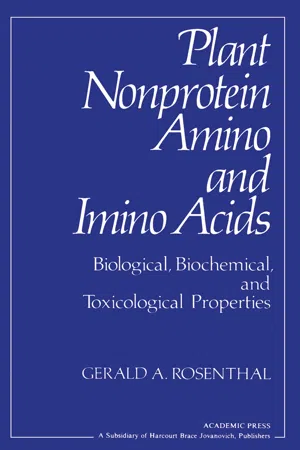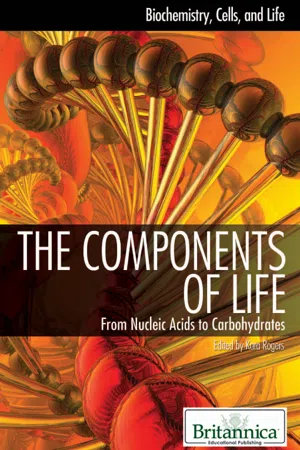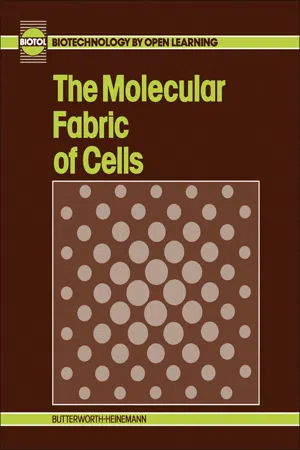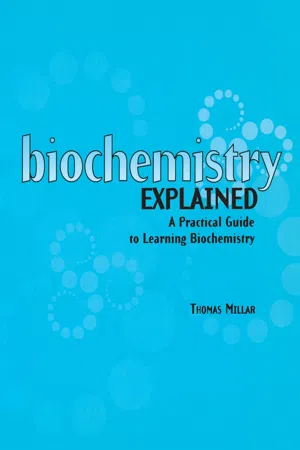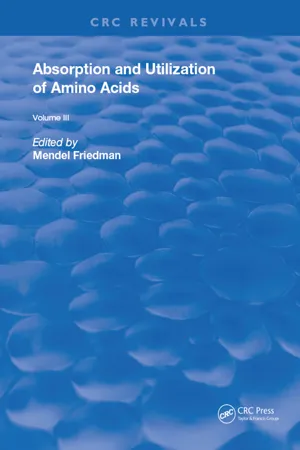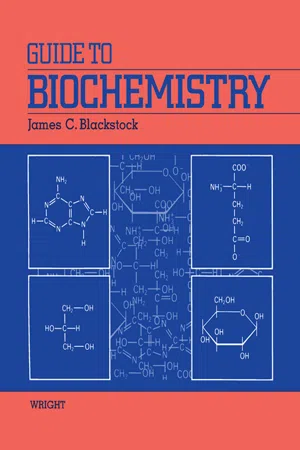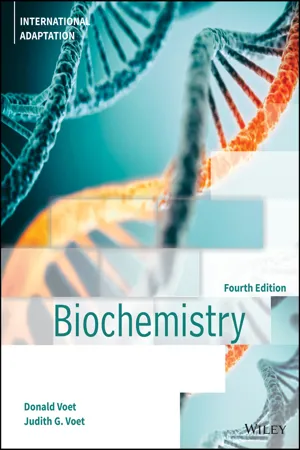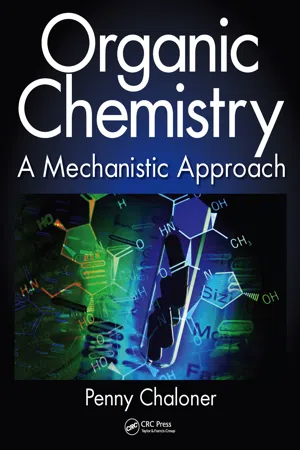Chemistry
Amino Group
An amino group is a functional group in organic chemistry consisting of a nitrogen atom bonded to hydrogen atoms. It is commonly found in amino acids, the building blocks of proteins, and is responsible for the basic properties of these compounds. Amino groups can participate in various chemical reactions, making them important in the synthesis of many organic compounds.
Written by Perlego with AI-assistance
Related key terms
1 of 5
10 Key excerpts on "Amino Group"
- eBook - PDF
Plant Nonprotein Amino and Imino Acids
Biological, Biochemical, and Toxicological Properties
- Gerald Rosenthal(Author)
- 2012(Publication Date)
- Academic Press(Publisher)
Chapter 1 These materials (amino acids) are at the same time substituted bases and substituted acids. Their capacity to function as amphoteric electrolytes has therefore conferred on them many remarkable electro-chemical properties not shared by any other product of natural origin. (Greenstein and Winitz, 1961). A. INTRODUCTION Nitrogen is the most abundant component of Earth's atmosphere but only a handful of higher plants can contribute to the utilization of this indispensable but relatively inert element. These higher plants, by virtue of symbiotic microbial associations, possess the unique ability to fix vast quantities of diatomic nitrogen into ammonia which is toxic and has limited biological utility until it is assimilated into organic linkage. The biosynthesis of amino acids represents the principal means for the assimilation of fixed nitrogen into biologically functional molecules. What exactly then is an amino acid? It is a substance having both an Amino Group and an organic acid. The labile proton can be de-rived not only from the customary carboxyl group but also by ioni-zation of sulfonic acid. For practical purposes, however, the term amino acid is applied to compounds sharing the general structure R—CH(NH 2 )COOH. While an Amino Group is usually linked directly to a carbon atom alpha to that of the carboxyl group, the Amino Group may ι Nomenclature and Certain Physicochemical Properties 2 1. Nomenclature and Certain Physicochemical Properties be associated with any carbon, such as in ß-alanine, H 2 N—CH 2 —CH 2 — COOH, or γ-aminobutyric acid, H 2 N — C H 2 — C H 2 — C H 2 — C O O H . As a group, the nonprotein amino acids are extremely diversified and it is not surprising that several systems can be employed for classifying and ordering these natural products. - eBook - ePub
The Components of Life
From Nucleic Acids to Carbohydrates
- Britannica Educational Publishing, Kara Rogers(Authors)
- 2010(Publication Date)
- Britannica Educational Publishing(Publisher)
CHAPTER 2Molecular Components: Amino AcidA mino acids are organic molecules that consist of a basic Amino Group (-NH2 ), an acidic carboxyl group (-COOH), and an organic R group (or side chain) that is unique to each amino acid. The term amino acid is short for “α-amino [alpha-amino] carboxylic acid.” Each molecule contains a central carbon (C) atom, termed the α-carbon, to which both an amino and a carboxyl group are attached. The remaining two bonds of the α-carbon atom are generally satisfied by a hydrogen (H) atom and the R group. The formula of a general amino acid is:The amino acids differ from each other in the particular chemical structure of their R group. Of over 100 natural amino acids, each with a different R group, only 20 make up the proteins of all living organisms. Humans can synthesize 10 of them (by interconversions, or mutual conversions) from each other or from other molecules of intermediary metabolism, but the other 10 (essential amino acids: arginine, histidine, isoleucine, leucine, lysine, methionine, phenylalanine, threonine, tryptophan, and valine) must be consumed in the diet.BUILDING BLOCKS OF PROTEINS
Proteins are of primary importance to the continuing functioning of life on Earth. Proteins catalyze the vast majority of chemical reactions that occur in the cell. They provide many of the structural elements of a cell, and they help to bind cells together into tissues. Some proteins act as contractile elements to make movement possible. Others are responsible for the transport of vital materials from the outside of the cell (“extracellular”) to its inside (“intracellular”). Proteins, in the form of antibodies, protect animals from disease and, in the form of interferon, mount an intracellular attack against viruses that have eluded destruction by the antibodies and other immune system defenses. Many hormones are proteins. Last but certainly not least, proteins control the activity of genes (“gene expression”). - eBook - PDF
- H. Stephen Stoker(Author)
- 2015(Publication Date)
- Cengage Learning EMEA(Publisher)
An Amino Group is the ! NH 2 functional group. Secondary and tertiary amines possess substituted Amino Groups. NH 2 O O O O A NH R A R R 9 N Disubstituted Amino Group Monosubstituted Amino Group Amino Group ▶ The word “amine” is pronounced “a-MEAN” (rhymes with “a bean”). ▶ Line-angle structural formulas for selected primary, secondary, and tertiary amines. NH 2 1 8 N 3 8 NH 2 8 NH 2 1 8 NH 2 1 8 ▶ Cyclic amines are the fourth type of heterocyclic compound to be considered; cyclic ethers (Section 3-19), cyclic forms of hemiacetals and acetals (Section 4-11), and cyclic esters (Section 5-11) were previously discussed. In cyclic amines, the heteroatom is nitrogen; in the other heterocyclic compounds, oxygen is the heteroatom. Classifying Amines as Primary, Secondary, or Tertiary Classify each of the following amines as a primary, secondary, or tertiary amine. NH CH 3 O N A CH 3 N CH 3 CH 3 CH 3 O A O a. c. b. d. NH 2 Solution The number of carbon atoms directly bonded to the nitrogen atom determines the amine classification. a. This is a secondary amine because the nitrogen is bonded to both a methyl group and a phenyl group. b. This is a tertiary amine because the nitrogen atom is bonded to three methyl groups. c. This is also a tertiary amine; the nitrogen atom is bonded to two phenyl groups and a methyl group. d. This is a primary amine. The nitrogen atom is bonded to only one carbon atom, a carbon atom in the carbon chain. ◀ E X A M PL E 6 -1 Cyclic amines exist. Such compounds, which are heterocyclic compounds (Section 3-19), are always either secondary or tertiary amines. N E H N E CH 3 2 ° Cyclic amine 3 ° Cyclic amine Numerous cyclic amine compounds are found in biochemical systems (Section 6-9). ◀ Copyright 2016 Cengage Learning. All Rights Reserved. May not be copied, scanned, or duplicated, in whole or in part. Due to electronic rights, some third party content may be suppressed from the eBook and/or eChapter(s). - eBook - PDF
- BIOTOL, B C Currell, R C E Dam-Mieras(Authors)
- 2013(Publication Date)
- Butterworth-Heinemann(Publisher)
Whilst an enormous number of amino acids probably exist, those which are incorporated into proteins are all of a type called -amino acids. Routinely, only 20 different -amino acids are found in proteins. An -amino acid is one in which both an Amino Group and a carboxyl group are joined to the same carbon atom, which is known as the -carbon atom (Figure 2.1). A hydrogen atom is also attached to the -carbon atom, as well as a fourth group, known collectively as a sidechain or R-group. It is through the structure of this sidechain that differences in amino acids arise. The simplest sidechain consists of a hydrogen atom (R=H), giving the amino acid glycine. The types of sidechains will be discussed shortly. COOH a 1 H 2 N~C-H I R Figure 2.1 The general structure of a- amino acids. The sidechain, which is different in different amino acids, is shown by the letter R. 18 Chapter 2 So far, we have depicted an -amino acid as 2-dimensional. In reality, it is of course 3-dimensional. Carbon has a valency of 4, meaning that it can form 4 single covalent bonds with other atoms. When a carbon atom does have 4 substituent groups, the bonds will be evenly distributed in space: the bonds will point to the four corners of a tetrahedron tetrahedron, with the -carbon atom at the centre of tetrahedron. A widely used way of describing chemical structures is by ball-and-stick models. If we do this for a-amino acids, and we symbolise each substituent group of the -carbon atom by a different coloured ball (-NH2, -COOH, -H and -R), we find that we can draw two structures. - eBook - ePub
Biochemistry Explained
A Practical Guide to Learning Biochemistry
- Thomas Millar(Author)
- 2018(Publication Date)
- CRC Press(Publisher)
4 Amino Acids and their Functions In this chapter you will learn:- the functional groups: an amine and carboxyl groups
- to understand the general structure of amino acid
- the structures, names and single letter symbols for the 20 amino acids found in proteins
- how 2 cysteines may be oxidised to form the bridging amino acid cystine
- how the carbons of amino acids are named or numbered
- the terms ampholyte and zwitterion and how these relate to amino acids
- the structure of an amide bond and the special case a peptide bond
- special functions of amino acids (e.g. neurotransmitters) and structural relationships between amino acids
- how ketones are formed from amino acids by removing ammonia from the αC
- the synthesis of the bioactive amines dopamine, noradrenaline, adrenaline and serotonin.
- to understand the basis for Parkinson’s disease and phenylketonuria
- that tyrosine, serine and threonine are phosphorylation sites in proteins
- the importance of decarboxylation in the formation of some active amines such as histamine
- how sugars may attach to the amino acids serine, threonine and asparagine
The name amino acid suggests that these structures have an amine and an acid group. Indeed this is true; amino acids have an Amino Group and a carboxylic acid. The structure of a typical L-amino acid is illustrated below. This type of amino acid is the basis of proteins.Basic structure and nomencalture of amino acids
Q&A 1 : Draw the chemical structures of a carboxylic acid, and an amine group.There is a central carbon that has bonds to an amine group, a carboxylic acid, an hydrogen and a variable R group. Since this central carbon has 4 different groups attached to it, it is a chiral carbon and hence there are 2 possible isomers, L and D. Nearly all amino acids in biochemistry are of the L-form (L for life). Note that this is the opposite of sugars, which nearly always occur as the D isomer. You need to learn their structure in this orientation. Remember that the L designation has nothing to do with the way they rotate polarised light, but is purely structural. This is based on the structure of L-glyceraldehyde. - eBook - ePub
- Mendel Friedman(Author)
- 2018(Publication Date)
- CRC Press(Publisher)
6 This is a simple and gentle technique based on the use of micro columns. It is followed by quantitative HPLC analysis of the genuine amino acids and/or different types of traditionally used methods of amino acid analysis.II. AMINO ACID GROUPSThe term amino acid is normally confined to carboxylic acids containing an aliphatic Amino Group, although a few other types of compounds can be included in this group. The Amino Group is most often a primary amine.FIGURE 1. Compounds containing both amino and acid groups. Secondary amines, e.g., the imino acids with the nitrogen in ring structures, as in proline and pipecolic acid derivatives and tertiary as well as quartemary amines (betaine) also occur in nature.Protein amino acids are without exception a-amino acids, but amino acids with the Amino Group in β, gamma, or δ position (e.g., β-Ala, gamma-ABA (GABA), δ-aminolevulinic acid) are well known natural products. Carboxylic acids with an aromatic Amino Group (e.g., amino-benzoic acids; anthranilate and p-aminobenzoate) or compounds with sulfonic acid groups (e.g., taurine) are also well known.The amino acids can be divided into protein amino acids and nonprotein amino acids. These two groups need to be considered separately in relation to analysis of amino acids in foods, body fluids, and tissues as they both are important in nutrition, in quality control of food and feed, and in many research applications. Protein amino acids can be divided into five biosynthetic families:1. Oxaloacetate or aspartate family (Asp, Asn, Thr, Met, Lys)2. α-Ketoglutarate or glutamate family (Glu, Gin, Pro, Arg, Lys)3. 3-Phosphoglycerate or serine family (Ser, Lys, Gly)4. Pyruvate and/or branched-chain amino acid family (Ala, Val, Leu, lie)5. Pentose or aromatic amino acid family (Phe, Tyr, Try, His)Structures of the amino acids are shown in Figure 2 . From an analytical point of view it is important to classify according to the functional groups in the side chain of the amino acids (the R-group; Figure 1 and 2 - eBook - ePub
- James C. Blackstock(Author)
- 2014(Publication Date)
- Butterworth-Heinemann(Publisher)
Today the immense variety of protein molecules is recognized. Proteins are the most abundant macromolecules found within cells and perform a wide variety of functions (Section 1.6). A protein can be considered as a unique polymer of amino acids (Section 1.4) which determine its chemical and structural properties. It is therefore imperative to consider the amino acids before embarkation upon a discussion of protein structure. Of the 308 catalogued natural amino acids, only 20 (plus a few derivatives) occur in proteins in which all are α-amino acids of the L -series (Section 1.3). They conform (except proline) to a general formula (Figure 4.1) in which an Amino Group and a carboxylic acid group are attached to the α-carbon (C α) atom. Proline, an imino acid, is normally included because of its occurrence in proteins. The properties of individual amino acids vary according to the nature of the R group called the side chain (Table 4.1). Asparagine and glutamine are considered as amide derivatives of aspartic acid and glutamic acid respectively. Tyrosine may be classified either by its hydroxy or aromatic group. To refer to amino acids in polypeptide sequences, three- or one-letter codes are frequently employed. L -α-Amino acids, with the exception of glycine, contain a chiral α-carbon atom (Section 1.3). These amino acids exhibit optical activity; in some cases, dextrorotatory, e.g. alanine, in other cases laevorotatory, e.g. phenylalanine. Because of the conjugated double-bond system of their aromatic rings, tyrosine, tryptophan and phenylalanine absorb light in the ultraviolet region - eBook - ePub
- Donald Voet, Judith G. Voet(Authors)
- 2021(Publication Date)
- Wiley(Publisher)
It is from these substances that proteins are synthesized through processes that we discuss in Chapter 27. Amino acids are also energy metabolites and, in animals, many of them are essential nutrients (Chapter 23). In addition, as we shall see, many amino acids and their derivatives are of biochemical importance in their own right (Section 3-4B). 1 The Amino Acids of Proteins The analyses of a vast number of proteins from almost every conceivable source have shown that all proteins are composed of the 20 “standard” amino acids listed in Table 3-1. These substances are known as α-amino acids because, with the exception of proline, they have a primary Amino Group and a carboxylic acid group substituent on the same carbon atom (Fig. 3-1 ; proline has a secondary Amino Group). Table 3-1 Covalent Structures and Abbreviations of the “Standard” Amino Acids of Proteins, Their Occurrence, and the p K Values of Their Ionizable Groups Name, Three-Letter Symbol, and One-Letter Symbol Structural Formula a Essential (e)/Non-essential (n) Residue Mass (D) b Average Occurrence in Proteins (%) c p K 1 α -COOH d p K 2 α -NH 3 + d p K R Side Chain d Amino acids with nonpolar side. chains Glycine Gly G (n) 57.0 7.1 2.35 9.78 Alanine Ala A (n) 71.1 8.3 2.35 9.87 Valine Val V (e) 99.1 6.9 2.29 9.74 Leucine Leu L (e) 113.2 9.7 2.33 9.74 Isoleucine Ile I (e) 113.2 6.0 2.32 9.76 Methionine Met M (e) 131.2 2.4 2.13 9.28 Proline Pro P (n) 97.1 4.7 1.95 10.64 Phenylalanine Phe F (e[--=PLGO-SEPA. RATOR=--]) 147.2 3.9 2.20 9.31 Tryptophan Trp W (e) 186.2 1.1 2.46 9.41 Amino acids with uncharged polar side. chains Serine Ser S (n) 87.1 6.5 2.19 9.21 Threonine Thr T (e) 101.1 5.3 2.09 9.10 Asparagine f Asn N (n) 114.1 4.0 2.14 8.72 Glutamine f Gln Q (n) 128.1 3.9 2.17 9.13 Tyrosine Tyr Y (n) 163.2 2.9 2.20 9.21 10.46 (phenol) Cysteine Cys C (n) 103.1 1.4 1.92 10.70 8.37 (sulfhydryl) Amino acids with charged polar side - eBook - PDF
Labs on Chip
Principles, Design and Technology
- Eugenio Iannone(Author)
- 2018(Publication Date)
- CRC Press(Publisher)
The example of the IR spectrum of an organic acid (2-bromobutanolic acid) is reported in Figure 1.32. 1.3.2.8 Amino Functional Group Amines are organic compounds and functional groups that contain a basic nitrogen atom with a electron pair. An electron pair or a Lewis pair consists of two electrons that occupy the same orbital TABLE 1.11 Summary of Names, Structures, and a Few Qualitative Properties of Common Addition Polymers Name(s) Formula Monomer Properties Polyethylene low density (LDPE) –(CH 2 –CH 2 ) n – Ethylene CH 2 ∙ CH 2 Soft, waxy solid Polyethylene high density (HDPE) –(CH 2 –CH 2 ) n – Ethylene CH 2 ∙ CH 2 Rigid, translucent solid Polypropylene (PP) different grades –[CH 2 –CH(CH 3 )] n – Propylene CH 2 ∙ CHCH 3 Atactic : soft, elastic solid Isotactic : hard, strong solid Poly(vinyl chloride) (PVC) –(CH 2 –CHCl) n – Vinyl chloride CH 2 ∙ CHCl Strong rigid solid Poly(vinylidene chloride) (Saran A) –(CH 2 –CCl 2 ) n – Vinylidene chloride CH 2 ∙ CCl 2 Dense, high-melting solid Polystyrene (PS) –[CH 2 –CH(C 6 H 5 )] n – Styrene CH 2 ∙ CHC 6 H 5 Hard, rigid, clear solid soluble in organic solvents Polyacrylonitrile (PAN, Orlon, Acrilan) –(CH 2 –CHCN) n – Acrylonitrile CH 2 ∙ CHCN High-melting solid soluble in organic solvents Polytetrafluoroethylene (PTFE, Teflon) –(CF 2 –CF 2 ) n – Tetrafluoroethylene CF 2 ∙ CF 2 Resistant, smooth solid Poly(methyl methacrylate) (PMMA, Lucite, Plexiglas) –[CH 2 –C(CH 3 )CO 2 CH 3 ] n – Methyl methacrylate CH 2 ∙ C(CH 3 )CO 2 CH 3 Hard, transparent solid Poly(vinyl acetate) (PVAc) –(CH 2 –CHOCOCH 3 ) n – Vinyl acetate CH 2 ∙ CHOCOCH 3 Soft, sticky solid cis -Polyisoprene natural rubber –[CH 2 –CH ∙ C(CH 3 ) –CH 2 ] n – Isoprene CH 2 ∙ CH–C(CH 3 ) ∙ CH 2 Soft, sticky solid requires vulcanization for practical us Polychloroprene (cis + trans) (Neoprene) –[CH 2 –CH ∙ CCl–CH 2 ] n – Chloroprene CH 2 ∙ CH–CCl ∙ CH 2 Tough, rubbery solid oil resistant 53 Elements of Organic Chemistry but have opposite spins. - eBook - PDF
Organic Chemistry
A Mechanistic Approach
- Penny Chaloner(Author)
- 2014(Publication Date)
- CRC Press(Publisher)
Chapter 4 – Heteroatom-Containing Functional Groups 79 The lone pair of electrons on ammonia and amines is associated with their basicity; you should be familiar with the reaction of ammonia with a proton (Figure 4.2). We can show what happens schematically by using the curly arrow; notice that the arrow starts from the lone pair of electrons on the amine and finishes in the gap between the nitrogen and the proton—where the new bond is being formed. Because of the analogy with ammonia, you should feel comfortable with the idea of amines as bases. The pK a value for a protonated amine, [R 3 NH] + , is about 9, so it is a stronger acid than water, but not as strong as H 3 O + . However, amines may also act as acids and can be deprotonated. For a typical secondary amine, the pK a is 36 (Equation 4.1). We will explore in more detail the acidity and basicity of all classes of compounds in Chapter 8. (4.1) R NH R N H 2 2 + harpoonrightleft - + occurs, the boiling points increase down the group as one would expect. In groups 15, 16, and 17, this is also true—except for the first member of the group, where hydrogen bond- ing is so important. Amines with N–H bonds will hydrogen bond in just the same way as does ammonia ( 4.4). The hydrogen bonds in amines are not as strong as those in water and alcohols but are still significant. The strength of hydrogen bonds reflects the electronegativity of the atom to which the hydrogen is attached and increases in the order N < O < F. Boiling points are thus higher for a non-hydrogen-bonded molecule with a comparable molecular weight. Hydrogen bonding is also important between molecules and solvents; thus, lower amines are water soluble, because they form H-bonds to water ( 4.5). N CH 3 H N CH 3 H H N CH 3 H O H H H H 4.4 4.5 NH 3 + H + [NH 4 ] + R 3 N: H + R 3 N + H FIGURE 4.2 Protonation.of.ammonia.and.amines.
Index pages curate the most relevant extracts from our library of academic textbooks. They’ve been created using an in-house natural language model (NLM), each adding context and meaning to key research topics.
